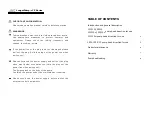
Chapter 2: Safety and Regulatory
5495975-1EN Rev.9
2-15
© 2013-2017 General Electric Company. All rights reserved.
Radiation Protection
Because exposure to X-ray radiation may be damaging to health, use great care to provide
protection against exposure to the primary beam. Some of the effects of X-ray radiation are
cumulative and may extend over a period of months or years. The best safety rule for X-ray
operator is “Avoid exposure to the primary beam at all times”.
Any object in the path of the primary beam produces secondary (scattered) radiation. The
intensity of the secondary radiation is dependent upon the energy and intensity of the
primary beam and the atomic number for the object material struck by the primary beam.
Secondary radiation may be of greater intensity than that of the radiation reaching the film.
Take protective measures to safeguard against it.
An effective protective measure is the use of lead shielding. To minimize dangerous exposure,
use such items as lead screens, lead impregnated gloves, aprons, thyroid collars, etc. The lead
screen should contain a minimum of 2.0 mm of lead or equivalent and personal protective
devices (aprons, gloves, etc.) must contain a minimum of 0.25 mm of lead or equivalent. For
confirmation of the local requirements at your site, please refer to your “Local Radiation
Protection Rules” as provided by your Radiation Protection Advisor.
CAUTION
While operating or servicing x-ray equipment, always keep a distance
not less than 2 meters from the focal spot and X-ray beam, protect body
and do not expose hands, wrists, arms or other parts of the body to the
primary beam.
Monitoring of Personnel
Monitoring of personnel to determine the amount of radiation to which they have been
exposed provides a valuable cross check to determine whether or not safety measures are
adequate. It may reveal inadequate or improper radiation protection practices and poten-
tially serious radiation exposure situations.
The most effective method of determining whether or not the existing protective measures
are adequate is the use of instruments to measure the exposure. These measurements
should be taken at all locations where the operator, or any portion of the body may be
exposed. Exposure must never exceed the accepted tolerable dose.
A common method of determining whether personnel have been exposed to excessive radia-
tion is the use of personal radiation dosimeters. These consist of X-ray sensitive film or ther-
moluminescent material enclosed within a holder that may be worn on the body. Even though
this device only measures the radiation which reaches the area of the body on which they are
worn, they do provide a reasonable indication of the amount of radiation received.
















































